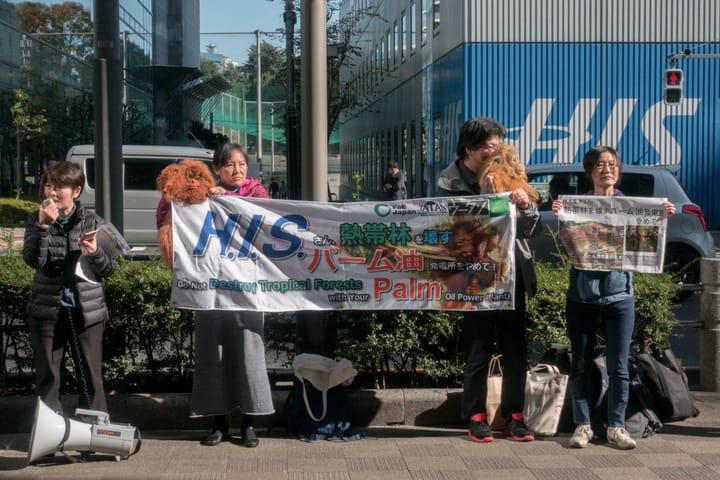Green Shield: How Japan is Pushing Carbon Capture in Southeast Asia

Last October, Japan helped launch the Asia Carbon Capture, Storage, and Utilization (CCUS) Network, its latest strategy for combating climate change. But the project, heavily backed by Japan’s Ministry of Economy, Trade and Industry (METI), has been criticized for providing cover for Japanese fossil fuel companies.
METI’s support for the CCUS Network is, in essence, support for Japanese oil and gas companies and their attempt to stay relevant and perpetuate fossil fuel revenues, say critics. That’s despite the government’s own commitments to net-zero by 2050 and emissions reductions under the Paris Agreement agreed to in 2015.
There are also concerns that CCUS technology is impractical and expensive, and unlikely to scale up quickly enough to actually help reduce greenhouse gas emissions. The ultimate goal may be something else entirely – allow Japanese companies to play a role in the development of fossil fuels in Southeast Asia, but under a green facade.
The goals were to support the expansion of CCUS technology to support carbon neutrality and net-zero goals not only in Japan, but across Southeast Asia, where Japanese oil and gas companies are currently exploring several CCUS projects in Indonesia.
“Japan, as a world leader in CCUS, is trying to push it,” says Putra Adhiguna, an Indonesia-based energy analyst at the non-profit Institute for Energy Economics and Financial Analysis. “We’re seeing quite a few [CCUS] projects on the ground being supported by Japanese companies.”
The argument made by METI and other groups supporting the expansion of CCS (Carbon dioxide Capture and Storage) in Southeast Asia is that without new technologies, it will be impossible to meet net-zero commitments due to the dependence on fossil-fuels for economic growth.
“Japan will drive pragmatic energy transformation using all fuels and technology so that the ASEAN region can achieve economic growth and carbon neutrality at the same time,” said Hiroshi Kajiyama, then Minister of Economy, Trade, and Industry, during an Asia CCUS Network event in late 2021.
During that event, METI officials also argued that Southeast Asia lacks the wind and solar energy resources of Europe or North America, making their deployment less financially viable. They also stated that it’s unrealistic to shift away from coal, a key power source in Japan and Southeast Asia, quickly.
“METI’s strategy for Japan’s electricity decarbonization by 2050, is to rely on such a technology for as much as 30 percent,” says Teruyuki Ohno, executive director at Renewable Energy Institute, a Tokyo-based think-tank.
As part of this, METI has helped subsidize the creation of a pilot CCS project on the northern island of Hokkaido. The Tomakomai Demonstration project, run by the Japan CCS Co., is located alongside a coastal oil refinery, and operated from 2016 to 2019. It is small, having only captured 0.3 metric tonnes of CO2 during its three-year demonstration period, a tiny fraction of the nearly 1 billion tonnes Japan emits annually. It remains unclear if this technology can be scaled in Japan, or exported to Southeast Asia.
“CCUS is still an incomplete technology. Especially in the power generation sector, there are hardly any examples of CCUS in operation,” said Ohno “Of the few plants with operation experience so far, the CO2 capture rate was recorded at only 60-70%. Moreover, it is very expensive.”
Uncertain Technologies
Ohno, Putra, and other environmental and energy experts are skeptical about the claims being made by METI and members of the Asia CCUS Network, and worry about the implications for Japan and Southeast Asia’s net-zero and Paris Agreement commitments. They also worry that the goal is not carbon neutrality, or greenhouse gas emissions reductions, but rather to create pathways to continue exploiting existing gas fields.
“This is the last line for the fossil fuel industry, because the only way they can get a social license to operate in the coming decades is basically to be able to make [CCUS] successful. The problem is that they haven’t been able to do it properly so far,” says Putra.
Though it lacks its own gas reserves, Japanese companies are major players in the global natural gas industry, including in gas-rich Southeast Asian nations like Malaysia, Brunei, Papua New Guinea and Indonesia. Globally, Japan was the world’s top importer of natural gas over the past decade, importing, in 2021, 21 percent of the world’s gas supply, about 74 million tons in total. 36 percent of Japan’s power generation comes from natural gas, which is also used in industry and chemicals.

CCUS is being pushed globally by the fossil fuel industry, including in Japan. Most of the Japanese companies involved in the Asia CCUS Network are also involved with natural gas exploration in Southeast Asia. JX Nippon Oil & Gas is a supporting member of the Asia CCUS Network, and has numerous operations across Southeast Asia, including with Indonesian and Malaysian state-owned oil and gas companies, and CCUS is part of its plants.
Meanwhile, another effort is being led by three Japanese companies – J-Power, JANUS, and JCG Corporation – in partnership with Indonesia’s state-owned oil and gas company Pertamina, who have started a feasibility study for a CCS project at the Gundih gas field on the island of Java. The project – likely several years away from being deployed if financing becomes available – aims to capture 300,000 tons of CO2 per year, aiming for 3 million tons over a decade.
Another project, a collaboration between Mitsui and Pertamina, was announced in April and aims to conduct a feasibility study for a CCUS project near the Rokan Block oil and gas field in Central Sumatra, Indonesia, though there are no details on its size or capacity.
In a press statement about the project, Toru Iijima, an executive at Mitsui, said “CCUS is expected to play a significant role in helping the Asia-Pacific region achieve a low-carbon economy while meeting its growing energy demand.”
These feasibility studies are the first signs of CCUS being pushed in the region, with Japan playing a central role. But METI’s support for the Asia CCUS Network is, in essence, support for Japanese oil and gas companies and their attempt to stay relevant and perpetuate fossil fuel revenues despite the government’s own commitments to net-zero by 2050 and emissions reductions under the Paris Agreement agreed to in 2015.
Ulterior Motives
Ohno and Putra think another issue may be at play here – a desire to export captured CO2 abroad. Japan lacks geological storage capacity and will need to find other places to store carbon, assuming its own domestic CCUS plans come to fruition.
“The real reason why they want to involve Asia in this old business model is that CO2 storage sites, which is the key to realize carbon capture, are not sufficiently available in Japan, and CO2 must be exported to Southeast Asia,” says Ohno.
Japan has long sent unwanted waste, such as plastic, abroad. The end result could be another form of a rich country dumping waste on a developing country.
“It’s so difficult to get a license to get a license or permit for storing CO2 in developed countries,” said Putra. “So let’s dump it in developing countries.”
When factoring everything together, Putra does not see a clear path for CCUS to play a major role in Japan or Southeast Asia’s decarbonization plans.
“I don’t think we’ll see [CCUS] will hold any real major role in Southeast Asia…it will be too expensive to be adopted anytime in the next two decades, especially in the power sector,” says Putra. This is concerning at a time when scientists are saying we need to act on reducing greenhouse gas emissions quickly.
“If we can’t solve this question for the next two decades, that’s a long time to be waiting for solutions,” added Putra.




